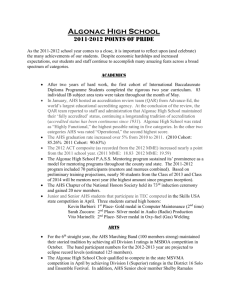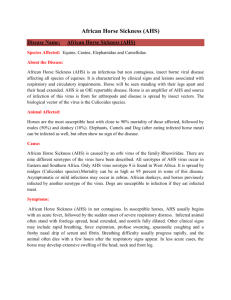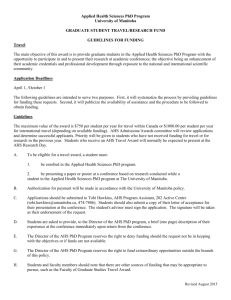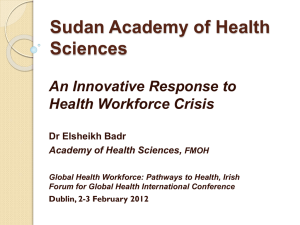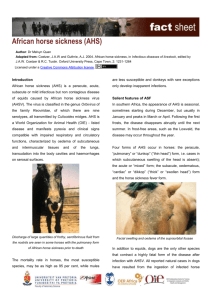Questionnaire
advertisement
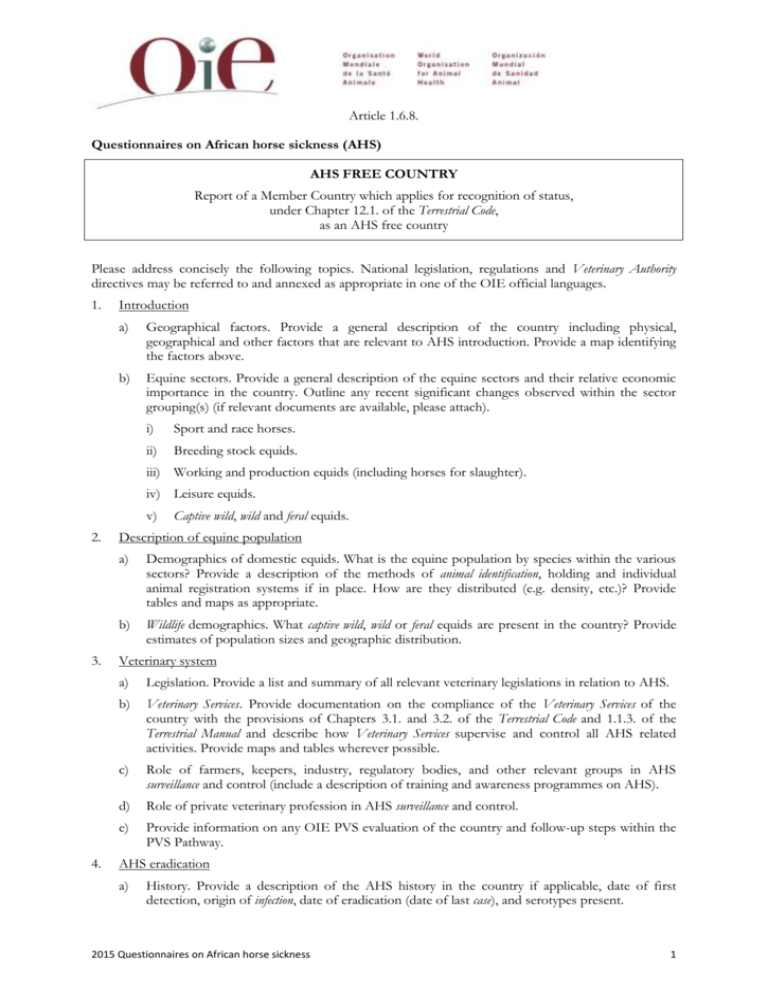
Article 1.6.8. Questionnaires on African horse sickness (AHS) AHS FREE COUNTRY Report of a Member Country which applies for recognition of status, under Chapter 12.1. of the Terrestrial Code, as an AHS free country Please address concisely the following topics. National legislation, regulations and Veterinary Authority directives may be referred to and annexed as appropriate in one of the OIE official languages. 1. Introduction a) Geographical factors. Provide a general description of the country including physical, geographical and other factors that are relevant to AHS introduction. Provide a map identifying the factors above. b) Equine sectors. Provide a general description of the equine sectors and their relative economic importance in the country. Outline any recent significant changes observed within the sector grouping(s) (if relevant documents are available, please attach). i) Sport and race horses. ii) Breeding stock equids. iii) Working and production equids (including horses for slaughter). iv) Leisure equids. v) 2. 3. 4. Captive wild, wild and feral equids. Description of equine population a) Demographics of domestic equids. What is the equine population by species within the various sectors? Provide a description of the methods of animal identification, holding and individual animal registration systems if in place. How are they distributed (e.g. density, etc.)? Provide tables and maps as appropriate. b) Wildlife demographics. What captive wild, wild or feral equids are present in the country? Provide estimates of population sizes and geographic distribution. Veterinary system a) Legislation. Provide a list and summary of all relevant veterinary legislations in relation to AHS. b) Veterinary Services. Provide documentation on the compliance of the Veterinary Services of the country with the provisions of Chapters 3.1. and 3.2. of the Terrestrial Code and 1.1.3. of the Terrestrial Manual and describe how Veterinary Services supervise and control all AHS related activities. Provide maps and tables wherever possible. c) Role of farmers, keepers, industry, regulatory bodies, and other relevant groups in AHS surveillance and control (include a description of training and awareness programmes on AHS). d) Role of private veterinary profession in AHS surveillance and control. e) Provide information on any OIE PVS evaluation of the country and follow-up steps within the PVS Pathway. AHS eradication a) History. Provide a description of the AHS history in the country if applicable, date of first detection, origin of infection, date of eradication (date of last case), and serotypes present. 2015 Questionnaires on African horse sickness 1 5. b) Strategy. Describe how AHS was controlled and eradicated (e.g. isolation of cases, stamping-out policy, zoning), provide time frame for eradication. c) Vaccines and vaccination. What type of vaccine was used? What equine species were vaccinated? Were vaccinated animals marked or was vaccination recorded in a unique identification document? d) Legislation, organisation and implementation of the AHS eradication campaign. Provide a description of the organizational structure at the different levels. Indicate if detailed operational guidelines were used and give a brief summary. e) Animal identification. Are equids identified (individually or at a group level)? f) Movements of equids. How are movements of equids controlled in the country? Provide evidence on the effectiveness of identification and movement controls of equids. Please provide information on pastoralism, transhumance and related movements. g) Leisure and competition movements of equids. How are movements of competition and leisure equids controlled in the country? Please provide information on systems including any use of registration. Provide information on any events that include international movements of equids. h) Describe the market systems for equids, in particular, if markets require the international movement of equids. AHS diagnosis Provide documentary evidence that the provisions in Chapters 1.1.2., 1.1.3., and 2.5.1. of the Terrestrial Manual are applied. In particular, the following points should be addressed: a) Is AHS laboratory diagnosis carried out in the country? If so, provide a list of approved laboratories. If not, provide the name(s) of and the arrangements with the laboratory(ies) samples are sent to, the follow-up procedures and the time frame for obtaining results. b) Provide an overview of the AHS approved laboratories, in particular to address the following points: i) Details on the types of tests undertaken. ii) Procedures for the official accreditation of laboratories. Give details of internal quality management systems, e.g. Good Laboratory Practice, ISO that exist in, or planned for, the laboratory system. iii) Give details of participation in inter-laboratory validation tests (ring tests). iv) Describe biosecurity measures applied, particularly in the case where live virus is handled. 6. AHS surveillance Provide documentary evidence that surveillance for AHS in the country complies with the provisions of Articles 12.1.11. to 12.1.13. of the Terrestrial Code, and Chapter 2.5.1. of the Terrestrial Manual. In particular, the following points should be addressed: a) Clinical suspicion. What are the criteria for raising a suspicion of AHS? What is the procedure to notify (by whom and to whom), is there a compensation system in place and what penalties are involved for failure to report? Provide a summary table indicating, for the past two years, the number of suspect cases, the number of samples tested for AHS, species, type of sample, testing method(s) and results (including differential diagnosis). b) Surveillance. Are the following undertaken? i) Serological surveillance. ii) Virological surveillance. iii) Sentinel animals. iv) Vector surveillance. If so, provide detailed information on the survey designs. How frequently are they conducted? Which were the equine species included? Are wildlife species included? Provide a summary table 2015 Questionnaires on African horse sickness 2 indicating detailed results, for at least the past two years. Provide details on follow-up actions taken on all suspicious and positive results. Provide criteria for selection of populations for targeted surveillance and numbers of equids examined and samples tested. Provide details on the methods selected and applied for monitoring the performance of the surveillance system. 7. AHS prevention a) Coordination with neighbouring countries. Are there any relevant factors about the adjacent countries or zones that have been taken into account (e.g. size, distance from adjacent border to infected equids)? Describe coordination, collaboration and information sharing activities with neighbouring countries. If the AHS free country borders an infected country or zone, describe the animal health measures implemented to effectively prevent the introduction of the agent or vectors, taking into consideration the seasonal vector conditions and existing physical, geographical and ecological barriers. b) Import control procedures From what countries or zones does the country authorize the import of equids or their products? What criteria are applied to approve such countries or zones? What controls are applied on entry of such equids and products, and subsequent internal movement? What import conditions (e.g. quarantine) and test procedures are required? Are import permits and health certificates required? What other procedures are used? Provide summary statistics of imports, temporary admissions or re-entry of equids and their products for at least the past two years, specifying country or zone of origin and volume. i) Provide a map with the number and location of ports, airports and land crossings. Is the service responsible for import controls part of the official services, or is it an independent body? If it is an independent body, describe its management structure, staffing levels and resources, and its accountability to the Competent Authority. Describe the communication systems between the Competent Authority and the border inspection posts, and between border inspection posts. ii) Describe the regulations, procedures, type and frequency of checks at the point of entry into the country or their final destination, concerning the import and follow-up of the following: – equids, – genetic material (semen, ova and embryos of the equine species), – equine derived (by-)products and biologicals. iii) Describe the action available under legislation, and actually taken, when an illegal introduction is detected. Provide information on detected illegal introduction. 8. Control measures and contingency planning a) Give details of any written guidelines, contingency plans (including information on vaccine banks) available to the Veterinary Services for dealing with suspected or confirmed cases of AHS. b) In the event of a suspected or confirmed AHS outbreak: i) is quarantine imposed on premises with suspicious cases, pending final diagnosis? ii) are movement restrictions applied on suspicion? iii) describe the sampling and testing procedures used to identify and confirm presence of the causative agent; iv) describe the actions taken to control the disease situation in and around any holdings found to be infected with AHS; v) describe the control or eradication procedures (e.g. vaccination, modified stamping-out policy); 2015 Questionnaires on African horse sickness 3 vi) describe the procedures used to confirm that an outbreak has been successfully controlled or eradicated, including conditions for restocking; vii) give details of any compensation made available when equids are killed, for disease control or eradication purposes. 9. Compliance with the Terrestrial Code a) In addition to the documentary evidence that the provisions of Article 12.1.2. are properly implemented and supervised, the Delegate of the Member Country must submit a declaration stating: i) The section under paragraph 1 (of Article 12.1.2.) on the base of which the application is made; ii) there has been no outbreak of AHS during the past 24 months; iii) no routine vaccination against AHS has been carried out during the past 12 months; b) and that vaccinated equids were imported in accordance with Chapter 12.1. 10. Recovery of status Member Countries applying for recovery of status should comply with the provisions of Article 12.1.5. of the Terrestrial Code and provide detailed information as specified in sections 4.a), 4.b), 4.c) and 6., and highlight any measures introduced to prevent a recurrence of the infection under section 7 of this questionnaire. Information in relation to other sections need only be supplied if relevant. 2015 Questionnaires on African horse sickness 4 AHS FREE ZONE Report of a Member Country which applies for recognition of status, under Chapter 12.1. of the Terrestrial Code, as an AHS free zone Please address concisely the following topics. National regulations and laws and Veterinary Authority directives may be referred to and annexed as appropriate in one of the OIE official languages. 1. Introduction a) Geographical factors. Provide a general description of the country and the zone including physical, geographical and other factors that are relevant to AHS introduction. Provide a map identifying the factors above. The boundaries of the zone must be clearly defined, including a protection zone, if applied. Provide a digitalised, geo-referenced map with a precise text description of the geographical boundaries of the zone (and of the protection zone) established in accordance with Chapter 4.3. b) Equine sectors. Provide a general description of the equine sectors and their relative economic importance in the country and the zone. Outline any recent significant changes observed within the sector grouping(s) (if relevant documents are available, please attach). i) Sport and race horses. ii) Breeding stock equids. iii) Working and production equids (including horses for slaughter). iv) Leisure equids. v) 2. 3. 4. Captive wild, wild and feral equids. Description of equine population a) Demographics of domestic equids. What is the equine population by species within the various sectors in the country and the zone? Provide a description of the methods of animal identification, holding and individual animal registration systems in the country and the zone if in place. How are they distributed (e.g. density, etc.)? Provide tables and maps as appropriate. b) Wildlife demographics. What captive wild, wild and feral equids. are present in the country and the zone? Provide estimates of population sizes and geographic distribution. Veterinary system a) Legislation. Provide a list and summary of all relevant veterinary legislations in relation to AHS. b) Veterinary Services. Provide documentation on the compliance of the Veterinary Services of the country with the provisions of Chapters 3.1. and 3.2. of the Terrestrial Code and 1.1.3. of the Terrestrial Manual and describe how Veterinary Services supervise and control all AHS related activities in the country and in the zone. Provide maps and tables wherever possible. c) Role of farmers, keepers, industry, regulatory bodies, and other relevant groups in AHS surveillance and control (include a description of training and awareness programmes on AHS). d) Role of private veterinary profession in AHS surveillance and control. AHS eradication a) History. Provide a description of the AHS history in the country and zone, if applicable, date of first detection, origin of infection, date of eradication in the zone (date of last case), and serotypes present. b) Strategy. Describe how AHS was controlled and eradicated in the zone (e.g. isolation of cases, stamping-out policy, zoning), provide time frame for eradication. 2015 Questionnaires on African horse sickness 5 5. c) Vaccines and vaccination. What type of vaccine was used in the zone and the rest of the country? What equine species were vaccinated? Were vaccinated animals marked or was vaccination recorded in a unique identification document? d) Legislation, organisation and implementation of the AHS eradication campaign. Provide a description of the organizational structure at the different levels. Indicate if detailed operational guidelines were used and give a brief summary. e) Animal identification. Are equids identified (individually or at a group level)? f) Movements of equids. How are movements of equids controlled in, and between zones of the country? Provide evidence on the effectiveness of identification of equids and movement controls in the zone. Please provide information on pastoralism, transhumance and related movements. g) Leisure and competition movements of equids. How are movements of competition and leisure equids controlled in the country and the zones? Please provide information on systems including any use of registration. Provide information on any events that include international movements of equids. h) Describe the market systems for equids in the country and the zones, in particular, if markets require the international movement of equids. AHS diagnosis Provide documentary evidence that the provisions in Chapters 1.1.2., 1.1.3., and 2.5.1. of the Terrestrial Manual are applied in the country and the zone. In particular, the following points should be addressed: a) Is AHS laboratory diagnosis carried out in the country and the zone? If so, provide a list of approved laboratories. If not, provide the name(s) of and the arrangements with the laboratory(ies) samples are sent to, the follow-up procedures and the time frame for obtaining results. Indicate the laboratory(ies) where samples originating from the zone are diagnosed. b) Provide an overview of the AHS approved laboratories, in particular to address the following points: i) Details on the types of tests undertaken. ii) Procedures for the official accreditation of laboratories. Give details of internal quality management systems, e.g. Good Laboratory Practice, ISO that exist in, or planned for, the laboratory system. iii) Give details of participation in inter-laboratory validation tests (ring tests). iv) Describe biosecurity measures applied, particularly in the case where live virus is handled. 6. AHS surveillance Provide documentary evidence that surveillance for AHS in the zone complies with the provisions of Articles 12.1.11. to 12.1.13. of the Terrestrial Code, and Chapter 2.5.1. of the Terrestrial Manual. In particular, the following points should be addressed: a) Clinical suspicion. What are the criteria for raising a suspicion of AHS? What is the procedure to notify (by whom and to whom), is there a compensation system in place and what penalties are involved for failure to report? Provide a summary table indicating, for the past two years, the number of suspect cases, the number of samples tested for AHS, species, type of sample, testing method(s) and results (including differential diagnosis) from the zone. b) Surveillance. Are the following undertaken? i) Serological surveillance. ii) Virological surveillance. iii) Sentinel animals. iv) Vector surveillance. 2015 Questionnaires on African horse sickness 6 If so, provide detailed information on the survey designs. How frequently are they conducted? Which were the equine species included? Are wildlife species included? Provide a summary table indicating detailed results, for at least the past two years. Provide details on follow-up actions taken on all suspicious and positive results. Provide criteria for selection of populations for targeted surveillance and numbers of equids examined and samples tested. Provide details on the methods selected and applied for monitoring the performance of the surveillance system. 7. AHS prevention a) Coordination with neighbouring countries. Are there any relevant factors about the adjacent countries or zones that have been taken into account (e.g. size, distance from adjacent border to infected equids)? Describe coordination, collaboration and information sharing activities with neighbouring countries and zones. If the AHS free zone is established in an AHS infected country or borders an infected country or infected zones, describe the animal health measures implemented to effectively prevent the introduction of the agent or vectors, taking into consideration the seasonal vector conditions and existing physical, geographical and ecological barriers. b) Import control procedures. From what countries or zones does the country authorize the import of equids or their products into the free zone? What criteria are applied to approve such countries or zones? What controls are applied on entry of such equids and products, and subsequent internal movement? What import conditions (e.g. quarantine) and test procedures are required? Are import permits and health certificates required? What other procedures are used? Provide summary statistics of imports, temporary admissions or re-entry of equids and their products to the free zone for at least the past two years, specifying country or zone of origin and volume. i) Provide a map with the number and location of ports, airports and land crossings in the zone. Is the service responsible for import controls part of the official services, or is it an independent body? If it is an independent body, describe its management structure, staffing levels and resources, and its accountability to the Competent Authority. Describe the communication systems between the Competent Authority and the border inspection posts, and between border inspection posts. ii) Describe the regulations, procedures, type and frequency of checks at the points of entry into the zone or their final destination, concerning the import and follow-up of the following: – equids, – genetic material (semen, ova and embryos of the equine species), – equine derived (by-)products and biologicals. iii) Describe the action available under legislation, and actually taken, when an illegal introduction into the zone is detected. Provide information on detected illegal introductions into the zone. 8. Control measures and contingency planning a) Give details of any written guidelines, contingency plans (including information on vaccine banks) available to the Veterinary Services for dealing with suspected or confirmed cases of AHS in the country and the zone (including the protection zone if applicable). b) In the event of a suspected or confirmed AHS outbreak in the zone: i) is quarantine imposed on premises with suspicious cases, pending final diagnosis? ii) are movement restrictions applied on suspicion? iii) describe the sampling and testing procedures used to identify and confirm presence of the causative agent; iv) describe the actions taken to control the disease situation in and around any holdings found to be infected with AHS; 2015 Questionnaires on African horse sickness 7 v) describe the control or eradication procedures (e.g. vaccination, modified stamping-out policy); vi) describe the procedures used to confirm that an outbreak has been successfully controlled or eradicated, including conditions for restocking; vii) give details of any compensation made available when equids are killed, for disease control or eradication purposes. 9. Compliance with the Terrestrial Code a) In addition to the documentary evidence that the provisions of Article 12.1.2. are properly implemented and supervised, the Delegate of the Member Country must submit a declaration stating: i) the section under paragraph 1 (of Article 12.1.2.) on the base of which the application is made; ii) there has been no outbreak of AHS during the past 24 months in the zone; iii) no routine vaccination against AHS has been carried out during the past 12 months in the zone; b) and that vaccinated equids were imported into the zone in accordance with Chapter 12.1. 10. Recovery of status Member Countries applying for recovery of status should comply with the provisions of Article 12.1.5. of the Terrestrial Code and provide detailed information as specified in sections 4.a), 4.b), 4.c) and 6. and highlight any measures introduced to prevent a recurrence of the infection under Section 7 of this questionnaire. 2015 Questionnaires on African horse sickness 8

